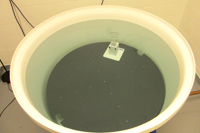Cognition and Learning
Spatial Memory
Barnes maze

The Barnes maze is used to test spatial learning and memory in rodents. The maze is a flat circular platform with 20 potential escape holes spread evenly around its circumference. The open, brightly lit surface is a mildly aversive stimulus, in contrast to the more acute stress of swimming in the Morris water maze (MWM). As with the MWM visual cues are present in the testing room as a basis for orientation and memory. A recessed chamber, the target box, can be place at any one of the escape holes. All other holes lead to false target boxes which are too shallow to allow the mouse to hide. The subject’s performance is recorded by video tracking software over multiple trials.
Sunyer B, Patil S, Hoger H, Lubec G. Barnes maze, a useful task to assess spatial reference memory in mice. Protocol Exchange (2007) published online: 4 October 2007, doi:10.1038/nprot.2007.390
Morris Water Maze, MWM (or Morris Water Task)

The MWM is a method to assess learning and spatial memory in mice. It exploits the instinct of mice to escape from water to a stable platform. Digital video tracking software records the mouse’s navigation in a 1.2m diameter tank to the location of an escape platform. Prominent, fixed visual cues are placed within the sightlines of the swimming mouse to allow for spatial orientation and as a basis for learning. The MWM is well suited to evaluation of hippocampus-dependant spatial memory and place learning (Vorhees and Williams, 2006).
Vorhees CV, Williams MT. Morris water maze: procedures for assessing spatial and related forms of learning and memory. Nat Protoc. 2006;1(2):848-58.
Conditioned Place Preference (CPP)

The CPP testing apparatus consists of three distinct chambers connected in series by vertical sliding “guillotine” style doors. A central, neutral starting chamber connects to one chamber with white walls/slotted floor and another with black walls/wire-grid floor, providing two distinct environmental contexts. Adjustable intensity lights are mounted in the lids of each chamber. Movement of the subject is tracked by infrared photo-beam breaks and recorded by computer. A conditioning phase consists of pairing a drug (or other experimental intervention) with confinement to one of the distinct chambers. An equal period of exposure to the alternate chamber is later provided and paired with the control treatment (saline or drug vehicle alone). Testing is then conducted by placing the mouse in the neutral start chamber and allowing free movement between the distinct environments. One advantage of CPP is that the effect of either appetitive or aversive treatments can be quantified.
Cunningham CL, Gremel CM, Groblewski PA. Drug-induced conditioned place preference and aversion in mice. Nat Protoc 1, 1662-1670 (2006). Published online: 16 November 2006, doi:10.1038/nprot.2006.279








